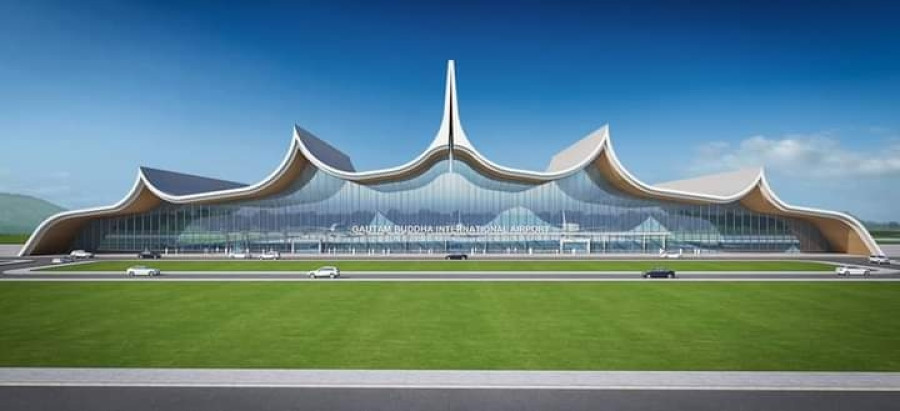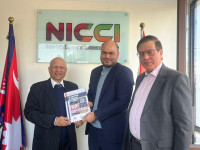Money
Asian Development Bank to give $150 million for airport improvement works
$60 million will be spent on building an international terminal building at Gautam Buddha International Airport in Bhairahawa.
Sangam Prasain
The Asian Development Bank is poised to issue $150 million to the Civil Aviation Authority of Nepal to upgrade the airports in Kathmandu and Bhairahawa.
This will be the largest funding package the multilateral agency has given to Nepal's civil aviation sector so far. The Nepal government will chip in $48 million for the improvement project.
According to an Asian Development Bank official, $60 million of the money will be spent on building a state-of-the-art international terminal building, known as Terminal 2 (T2), at Gautam Buddha International Airport in Bhairahawa.
Another $100 million has been earmarked for building a parallel taxiway at the southern side of the runway of Tribhuvan International Airport and a new hangar apron facility at the eastern side of the runway.
The total cost of the project, including value added tax, is $198 million.
“We have completed loan negotiations with the Finance Ministry. The Asian Development Bank’s board of directors will soon approve the loan,” said Naresh Pradhan, senior project officer (transport) at the bank.
“Following the approval, the bank and Nepal’s civil aviation body will formally sign the loan and project execution agreements,” he said.
On September 24, the cabinet gave its okay to the Finance Ministry to begin negotiations for a concessional loan with the Asian Development Bank, which is issuing the funds through its South Asia Sub-Regional Economic Cooperation Airport Capacity Enhancement Project.
The terminal currently being built at Gautam Buddha International Airport has been deemed too small for an international terminal, and it will be repurposed for domestic flights, according to Rajan Pokhrel, director general of the Civil Aviation Authority of Nepal.
The 15,000-square-metre building, which is in the final stages of completion, has only six parking bays and lacks an aerobridge.
The idea of constructing a bigger terminal building was originally floated by the Finance Ministry following concerns that the current terminal may not be large enough to accommodate forecasted passenger traffic growth.
T2 is expected to be 35,000 square metres in area, nearly as large as the terminal at Kathmandu’s Tribhuvan International Airport. The proposed new building will have at least 15 parking bays and be fitted with aerobridges, according to the Asian Development Bank’s document.
Severe congestion at Tribhuvan International Airport, which has only 11 parking bays, with two added last month, prompted the ministry to ask the project to develop a bigger facility, officials said. The planned new terminal T2 will be erected in the west of the existing terminal.
The Civil Aviation Authority of Nepal has acquired 25.76 hectares of land for the construction of T2 and other facilities in the future.
The national pride project in Bhairahawa has been envisaged to serve the fast-rising business and industrial hub of Bhairahawa, and facilitate international pilgrimage to Lumbini, the birthplace of Lord Buddha.
As part of the improvement plan at Tribhuvan International Airport in Kathmandu, a 1,140-metre-long parallel taxiway will be built at the southern side, or the Koteshwor side, of the runway. This will connect the existing international apron to the end of runway 02.
As the taxiway does not extend along the full length of the runway, aircraft face delays before landing and taking off as they have to wait for other aircraft to clear the runway, creating congestion at the country’s sole international airport.
There are two parallel taxiway projects: Extension of the parallel taxiways at the northern and southern parts of the runway. The northern part too is jointly funded by the government and the Asian Development Bank, and the construction contract has already been awarded, said airport officials.
Two hangar aprons are planned to be constructed at the east side of the airport. The existing hangars of Nepal Airlines and the Nepal Army will be relocated to the eastern side, according to the airport official.
Hangar Apron No 1 will be constructed for Nepal Airlines complementing Buddha Air’s hangar, according to the Asian Development Bank’s document. The apron will have parking capacity for two Code C aircraft like the Boeing 737-700 and the Airbus A-320; and three Code E aircraft like the Boeing 747 and the Airbus 340.
Hangar No 2 for the Nepal Army is located at the south side of the deep well used for water supply and the airport's radar station.
The apron will have parking space for three Code C aircraft and four fixed-wing aircraft including the MI-17, the document says. The runway side strips will be improved complementing these hangar aprons and associated taxiways.
The construction project at Kathmandu airport will last three years. According to the bank, the building contract will likely be awarded in the first quarter of 2021.
Overcrowding at Kathmandu’s airport is becoming worse by the day as airlines are aggressively expanding their fleets in response to growing air travel demand in the country.




 8.12°C Kathmandu
8.12°C Kathmandu













